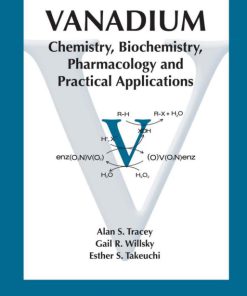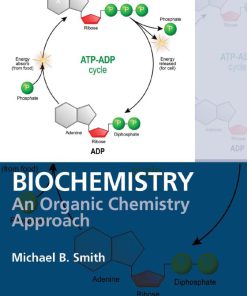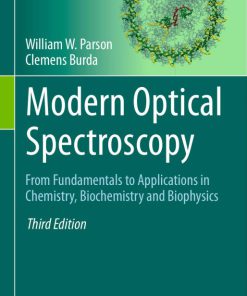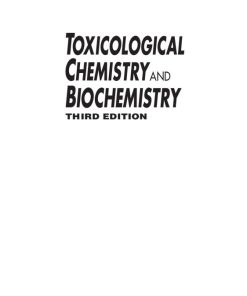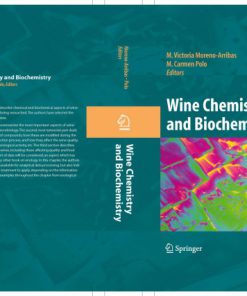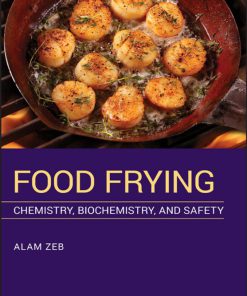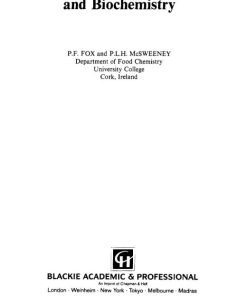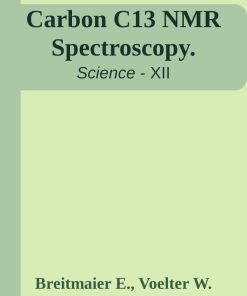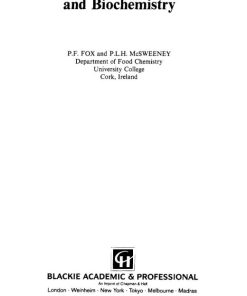Flavonoids Chemistry Biochemistry And Applications 1st Edition by Øyvind Andersen, Kenneth Markham 0849320216 9780849320217
$50.00 Original price was: $50.00.$25.00Current price is: $25.00.
Authors:Øyvind M. Andersen , Series:Biochemistry [56] , Tags:Science › Life Sciences › Botany Science / Chemistry / General Science / Life Sciences / Botany Technology & Engineering / Food Science / General , Author sort:Andersen, Øyvind M. , Languages:Languages:eng , Published:Published:Nov 2005 , Publisher:Taylor & Francis , Comments:Comments:Advances in the flavonoid field have been nothing short of spectacular over the last 20 years. While the medical field has noticed flavonoids for their potential antioxidant, anticancer and cardioprotectant characteristics, growers and processors in plant sciences have utilized flavonoid biosynthesis and the genetic manipulation of the flavonoid pa
Flavonoids Chemistry Biochemistry And Applications 1st Edition by Øyvind Andersen, Kenneth Markham – Ebook PDF Instant Download/Delivery. 0849320216, 9780849320217
Full download Flavonoids Chemistry Biochemistry And Applications 1st Edition after payment
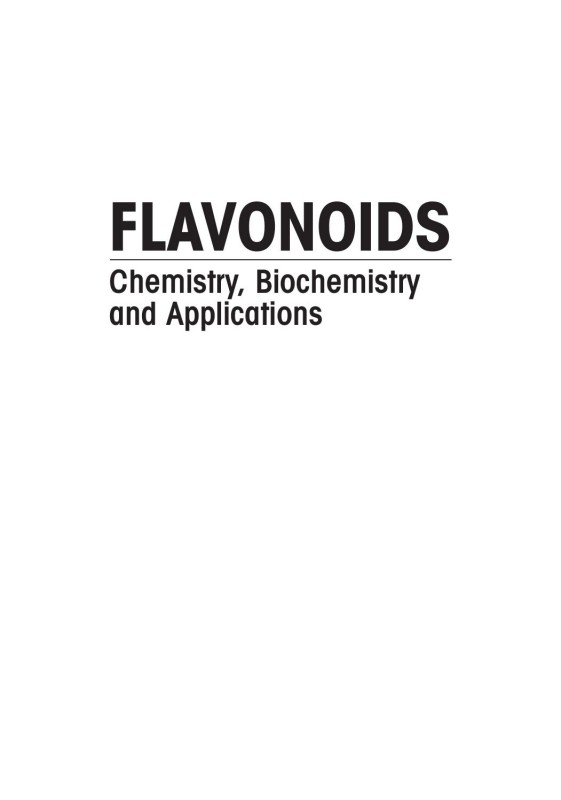
Product details:
ISBN 10: 0849320216
ISBN 13: 9780849320217
Author: Øyvind M. Andersen, kenneth R. Markham
Advances in the flavonoid field have been nothing short of spectacular over the last 20 years. While the medical field has noticed flavonoids for their potential antioxidant, anticancer and cardioprotectant characteristics, growers and processors in plant sciences have utilized flavonoid biosynthesis and the genetic manipulation of the flavonoid
Flavonoids Chemistry Biochemistry And Applications 1st Table of contents:
1. Separation and Quantification of Flavonoids
1.1 Introduction
1.2 Extraction
1.3 Preparative Separation
1.3.1 Preliminary Purification
1.3.2 Preparative Methods
1.3.2.1 High-Performance Liquid Chromatography
1.3.2.2 Medium-Pressure Liquid Chromatography
1.3.2.3 Centrifugal Partition Chromatography
1.4 Analytical Methods
1.4.1 Sample Preparation
1.4.2 Thin-Layer Chromatography
1.4.3 High-Performance Liquid Chromatography
1.4.4 High-Performance Liquid Chromatography-Ultraviolet Spectrophotometry
1.4.5 High-Performance Liquid Chromatography-Mass Spectrometry
1.4.6 High-Performance Liquid Chromatography-Nuclear Magnetic Resonance
1.4.7 Capillary Electrophoresis
1.5 Outlook
References
2. Spectroscopic Techniques Applied to Flavonoids
2.1 Introduction
2.2 NMR Spectroscopy
2.2.1 Introduction
2.2.2 NMR Solvents
2.2.3 NMR Experiments
2.2.3.1 COSY and TOCSY
2.2.3.2 1H−13C Heteronuclear NMR Experiments
2.2.3.3 Improved Versions of the HMBC Experiment
2.2.3.4 Nuclear Overhauser Enhancement Spectroscopy
2.2.3.5 Rotating Frame Overhauser Effect Spectroscopy
2.2.3.6 Two- and Three-Dimensional HSQC-TOCSY, HSQC-NOESY, HSQC-ROESY, HMQC-NOESY, HMQC-ROESY
2.2.4 Solid-State NMR
2.2.5 Liquid Chromatography-NMR
2.2.6 NMR Data on Flavonoid Classes
2.3 Mass Spectrometry
2.3.1 MS Instrumentation and Techniques
2.3.1.1 Electron Impact and Chemical Ionization
2.3.1.2 Fast Atom Bombardment
2.3.1.3 Matrix-Assisted Laser Desorption Ionization
2.3.1.4 Electrospray Ionization and Atmospheric Pressure Chemical Ionization
2.3.1.5 Tandem (MS–MS) and Multiple (MSn) Mass Spectrometry
2.3.1.6 Mass Analyzers
2.3.2 Coupled Techniques Involving Mass Spectrometry
2.3.2.1 Gas Chromatography Coupled to Mass Spectrometry
2.3.2.2 High-Performance Liquid Chromatography Coupled to Mass Spectrometry
2.3.2.3 Capillary Electrophoresis Coupled to Mass Spectrometry
2.3.3 Structural Information
2.3.4 Quantitative Considerations
2.4 Vibrational Spectroscopy (IR and Raman)
2.4.1 IR and Raman Spectroscopic Techniques in Studies of Flavonoid Structures
2.4.2 IR and Raman Spectroscopic Techniques in Studies of Complexes Involving Flavonoids
2.4.3 Two-Dimensional IR Analysis
2.4.4 Coupled Techniques Involving Vibrational Spectroscopy
2.4.5 Near-Infrared Spectroscopy
2.5 Ultraviolet-Visible Absorption Spectroscopy
2.5.1 Online UV Absorption Spectroscopy in Chromatography
2.5.2 UV–Vis Absorption Spectroscopy on Anthocyanins
2.5.3 UV–Vis Absorption Spectroscopy Involving Flavonoids in Complexes
2.6 Color Measurements Using Commission Internationale de l’Eclairage Specifications
2.6.1 Colorimetric Studies on Pure Anthocyanins
2.6.2 Anthocyanin-Based Colors of Plants and Products Derived Therefrom
2.7 Circular Dichroism Spectroscopy
2.7.1 Determination of Absolute Flavonoid Configuration
2.7.2 Circular Dichroism in Studies of Molecular Flavonoid Interaction
2.8 X-Ray Crystallography
2.8.1 X-Ray Studies on Flavonoid Structures
2.8.2 X-Ray Studies on Complexes Involving Flavonoids
References
3. Molecular Biology and Biotechnology of Flavonoid Biosynthesis
3.1 The Scope of the Review
3.2 Overview of Flavonoid Biosynthesis
3.3 Biosynthesis of Flavonoid Precursors
3.3.1 Acetyl-CoA Carboxylase
3.3.2 Phenylalanine Ammonia Lyase
3.3.3 Cinnamate 4-Hydroxylase
3.3.4 4-Coumarate:CoA Ligase
3.3.5 Modification of Hydroxycinnamic Acid-CoA Esters
3.4 Formation of Anthocyanins
3.4.1 Chalcone Synthase
3.4.2 Chalcone Isomerase
3.4.3 Flavanone 3β-Hydroxylase
3.4.4 Dihydroflavonol 4-Reductase
3.4.5 Anthocyanidin Synthase
3.4.6 Formation of Anthocyanidin 3-O-Glycoside
3.4.7 Formation of 3-Deoxyanthocyanin
3.4.8 Flavonoid 3′-Hydroxylase and Flavonoid 3′,5′-Hydroxylase
3.4.9 Anthocyanin Modification Enzymes
3.4.9.1 Anthocyanin Glycosyltransferases
3.4.9.2 Anthocyanin Methyltransferases
3.4.9.3 Anthocyanin Acyltransferases
3.5 Formation of Proanthocyanidins and Phlobaphenes
3.5.1 Leucoanthocyanidin Reductase
3.5.2 Anthocyanidin Reductase
3.5.3 Proanthocyanidin Polymerization
3.6 Formation of Flavones and Flavonols
3.7 Flavone and Flavonol Modification Enzymes
3.7.1 Flavone and Flavonol Glycosyltransferases
3.7.2 Flavone and Flavonol Methyltransferases
3.7.3 Flavone and Flavonol Sulfotransferases
3.8 Biosynthesis of 5-Deoxyflavonoids
3.9 Biosynthesis of Isoflavonoids and their Derivatives
3.9.1 2-Hydroxyisoflavanone Synthase
3.9.2 4′-O-Methylation
3.9.3 Isoflavone 2′- and 3′-Hydroxylase
3.9.4 Isoflavone Reductase
3.9.5 Vestitone Reductase
3.9.6 Pterocarpan 6a-Hydroxylase
3.9.7 SAM:6a-Hydroxymaackiain 3-O-Methyltransferase
3.9.8 Pterocarpan Prenyltransferases
3.9.9 Prenylpterocarpan Cyclases
3.9.10 Isoflavonoid Glucosyltransferases and Malonyltransferases
3.9.11 Flavonoid 6-Hydroxylase
3.10 Formation of Aurones
3.11 Other Activities of Flavonoid Biosynthesis
3.12 Vacuolar Importation of Flavonoids
3.13 Enzyme Complexes and Metabolic Channeling
3.14 Assigning Enzyme Function from DNA Sequence or Recombinant Proteins
3.15 Regulation of Flavonoid Gene Transcription
3.15.1 Environmental Regulation of Early Biosynthetic Steps
3.15.2 Regulation of Anthocyanin Biosynthesis
3.15.3 Regulation of Proanthocyanidin Biosynthesis
3.15.4 Regulation of the Production of Other Flavonoids
3.16 Genetic Modification of Flavonoid Biosynthesis
3.16.1 Preventing Flavonoid Production
3.16.2 Redirecting Substrate in the Flavonoid Pathway
3.16.3 Introducing Novel Flavonoid Compounds
3.16.3.1 Chalcones, Aurones, and Flavonols
3.16.3.2 Altering Dihydroflavonol 4-Reductase Activity
3.16.3.3 Isoflavonoids
3.16.3.4 Altering B-Ring Hydroxylation
3.16.3.5 Altering Secondary Modifications
3.16.4 Modulating Pathway Regulation
3.17 Concluding Comments
3.18 Acknowledgments
References
4. Flavonoids in Foods
4.1 Introduction
4.2 Database Development
4.2.1 Database Development
4.2.2 Selection of Foods and Flavonoid Classes
4.2.3 Collation and Evaluation of Literature Sources
4.3 Database of Flavonoids in Foods
4.3.1 Fruits
4.3.2 Vegetables
4.3.3 Beverages
4.3.4 Miscellaneous Foods
4.4 Quality and Completeness of Flavonoid Content Data
4.4.1 Factors Affecting Flavonoid Content of Food
4.4.1.1 Analytical Variations
4.4.1.2 Environmental Factors
4.4.1.3 Species Characteristics
4.4.1.4 Processing and Storage
4.5 Estimated Dietary Flavonoid Intake
4.5.1 Estimation of Dietary Flavonoid Intake
4.5.2 Previous Estimations of Dietary Flavonoid Intake
4.5.3 Estimation of Scottish Dietary Flavonoid Intake Using the New Comprehensive Flavonoid Database
4.5.4 Comparison with Other Estimates of Dietary Flavonoid Intake
4.5.5 Future Requirements to Improve Database
4.6 Conclusions
4.7 Acknowledgments
References
Appendix 1
Botanical Names of Fruits
Botanical Names of Vegetables
Botanical Names of Herbs and Spices
Botanical Names of Legumes
Appendix 2: References Used for Database Compilation
5. Flavonoids in Wine
5.1 Introduction
5.2 Analytical Procedures
5.2.1 Extraction and Fractionation of Flavonoids from Grape and Wine
5.2.2 Analysis of Lower Molecular Weight Flavonoids
5.2.2.1 ]HPLC Coupled to Mass Spectrometry
5.2.2.2 Analysis of Flavonoid Constitutive Moieties
5.2.2.3 Nuclear Magnetic Resonance
5.2.3 Analysis of Higher Molecular Weight Flavonoids
5.2.3.1 Acid-Catalyzed Cleavage in the Presence of Nucleophilic Agents
5.2.3.2 Mass Spectrometry
5.3 Grape Flavonoids
5.3.1 Structure and Distribution in Grape
5.3.1.1 Anthocyanins
5.3.1.2 Flavanols
5.3.1.3 Flavonols, Flavones, and Dihydroflavonols
5.3.2 Impact ofVarietal and Environmental Factors on Grape Flavonoids
5.4 Extraction of Grape Flavonoids into the Wine
5.5 Reactions of Flavonoids in Musts and Wines
5.5.1 Reactivity ofFlavonoid Compounds
5.5.2 Enzymatic Reactions
5.5.2.1 Hydrolytic Enzymes
5.5.2.2 Enzymatic Oxidation and Subsequent Reactions
5.5.3 Chemical Reactions
5.5.3.1 Products of Direct Anthocyanin-Flavanol Addition
5.5.3.2 Products of Acetaldehyde-Mediated Reactions
5.5.3.3 Other Pyranoanthocyanins
5.5.3.4 Condensation Reactions with Other Aldehydes
5.5.4 Factors Controlling Flavonoid Reactions in Wine
5.6 Physicochemical and Organoleptic Properties of Grape and Wine Flavonoids
5.6.1 Impact of Flavonoid Reactions on Wine Color
5.6.2 Impact of Flavonoid Reactions on Wine Taste Properties
References
6. Dietary Flavonoids and Health — Broadening the Perspective
6.1 Introduction
6.2 The Diversity of Dietary PPT
6.3 The Intake of PPT
6.4 Absorption of PPT and the Nature of the Plasma Metabolites
6.4.1 Introduction
6.4.2 Flavanols, Flavanol Gallates, and Proanthocyanidins
6.4.3 Flavonol Glycosides
6.4.4 Flavones and Polymethylflavones
6.4.5 Isoflavones
6.4.6 Flavanones
6.4.7 Chalcones, Dihdyrochalcones, and Retrochalcones
6.4.8 Anthocyanins
6.4.9 Stilbenes
6.4.10 Hydroxybenzoic Acids, Hydroxycinnamic Acids, and Associated Conjugates
6.4.11 Oleuropein, Tyrosol, and Hydroxytyrosol
6.4.12 Hydrolyzable Tannins
6.4.13 Lignins and Lignans
6.4.14 Derived Polyphenols
6.4.15 Person-to-Person Variation
6.5 PPT Metabolites in Tissues
6.5.1 Pseudo-Pharmacokinetic and Redox Properties
6.5.2 Binding to Plasma Proteins
6.5.3 Effects on the Vascular System
6.5.4 Transformation of PPT Metabolites after Absorption
6.6 PPT Prior to Absorption
6.6.1 Interaction with Tissues and Nutrients Prior to Absorption
6.6.2 Modulation of the Gut Microflora — Prebiotic Effects
6.6.3 Modulation of the Postprandial Surge in Plasma Glucose — Glycemic Index
6.7 Safety Assessment of Dietary PPT
6.8 Conclusions and Future Research Requirements
References
7. Isoflavonoids and Human Health
7.1 Introduction
7.2 Isoflavonoids: Dietary Sources and Intakes, Metabolism, and Bioavailability
7.2.1 Dietary Sources and Intakes
7.2.2 Metabolism and Bioavailability
7.3 Isoflavonoids and Cancer Prevention
7.3.1 Hormone-Dependent Cancer Prevention by Isoflavonoids
7.3.2 Estrogens and Risk of Breast Cancer
7.3.3 Estrogen Receptor Mediated Events
7.3.4 Animal Models
7.3.5 Mechanisms of Anticancer Action of Isoflavonoids
7.3.6 Clinical Studies
7.4 Protection by Isoflavonoids against Cardiovascular Disease
7.4.1 Cholesterol-Lowering and Isoflavonoids
7.4.2 Antioxidant Action
7.4.3 Arterial Function
7.4.4 Cellular Effects
7.5 Protection by Isoflavonoids against Osteoporosis, Cognitive Decline, and Menopausal Symptoms?
7.5.1 Osteoporosis
7.5.2 Menopausal Symptoms and Cognitive Decline
7.6 Isoflavonoids: Potential Risks
7.7 Isoflavonoids and Human Health: Conclusions
References
8. Flavonoid Functions in Plants
8.1 Introduction
8.2 Anthocyanins and 3-Deoxyanthocyanins
8.2.1 Defense
8.2.2 Protection from Solar Ultraviolet
8.2.3 Photoprotection
8.2.4 Antioxidant Activity
8.2.5 Anthocyanins as a Generalized Stress Response
8.3 Colorless Flavonoids
8.3.1 Stress Protection
8.3.1.1 Ultraviolet Radiation
8.3.1.2 Temperature Stress
8.3.1.3 Heavy Metal Tolerance
8.3.1.4 Oxidative Stress
8.3.2 Reproduction and Early Plant Development
8.3.2.1 Chemical Signals as Attractants for Pollination and Seed Dispersal
8.3.2.2 Flavonoids in Pollen, and Their Role in Plant Sexual Reproduction
8.3.2.3 Seeds and Seedling Development
8.3.3 Signaling — A Role as Chemical Messengers
8.3.3.1 Defense Against Pathogenic Microbes
8.3.3.2 Roles in Agrobacterium Infection
8.3.3.3 Legume Nodulation
8.3.3.4 Mycorrhizal Fungi
8.3.3.5 Parasitic Plants
8.3.3.6 Regulation of Auxin
8.3.4 Protection from Insect and Mammalian Herbivory
8.4 Conclusions
References
9. Flavonoid-Protein Interactions
9.1 General Considerations
9.1.1 The Biological Significance of Flavonoid-Protein Interactions in Man
9.1.2 Molecular Interactions Responsible for Flavonoid–Protein Complexation
9.1.3 Specificity of Flavonoid-Protein Interactions
9.2 Examples of Flavonoid-Protein Interactions in Man
9.2.1 Interactions Prior to Intestinal Absorption
9.2.1.1 Interactions with Salivary Proteins and Astringency
9.2.1.2 Interactions in the Gastrointestinal Tract
9.2.2 Interactions Involved in Flavonoid Bioavailability
9.2.2.1 Intestinal Absorption
9.2.2.2 Conjugation Enzymes
9.2.2.3 Plasma Proteins
9.2.3 Interactions Potentially Involved in Cellular Health Effects
9.2.3.1 ATP-Binding Proteins
9.2.3.2 Ligand–Receptor Interactions
9.2.3.3 Redox Enzymes
9.2.3.4 Modulation of Antioxidant Properties and Oxidation Pathways by Binding to Proteins
9.3 Conclusion and Perspectives
References
10. The Anthocyanins
10.1 Introduction
10.1.1 Anthocyanin Structures
10.1.2 Nutritional Supplements — Health Aspects
10.1.3 Food Colorants
10.1.4 Molecular Biology, Biosynthesis, and Functions
10.1.5 Analytical Methods and Instrumentation
10.2 Anthocyanin Chemistry
10.2.1 General Aspects and Nomenclature
10.2.2 Anthocyanidins
10.2.3 Anthocyanins Not Based on the Common Anthocyanidins
10.2.4 Glycosides
10.2.4.1 Monosaccharides
10.2.4.2 Disaccharides
10.2.4.3 Trisaccharides
10.2.4.4 Glycosidic Linkages
10.2.5 Anthocyanins with Acylation
10.2.5.1 Acylation with Phenolic Acids
10.2.5.2 Acylation with Aliphatic Acids
10.2.6 Dimeric Flavonoids Including an Anthocyanin Unit
10.2.7 Metalloanthocyanins
10.2.8 Anthocyanin Colors and Stability
10.3 Anthocyanin Production
10.3.1 Cell Cultures
10.3.2 Synthesis
10.4 Anthocyanin Localization in Plant Cells
10.5 Chemotaxonomic Patterns
10.5.1 Alliaceae
10.5.2 Convolvulaceae
10.5.3 Cruciferae
10.5.4 Gentianaceae
10.5.5 Geraniaceae
10.5.6 Labiatae
10.5.7 Leguminosae
10.5.8 Liliaceae
10.5.9 Nymphaeaceae
10.5.10 Orchidaceae
10.5.11 Ranunculaceae
10.5.12 Solanaceae
References
Appendix
11. Flavans and Proanthocyanidins
11.1 Introduction
11.2 Nomenclature
11.3 Structures and Distribution
11.3.1 Flavans, Flavan-3-ols, Flavan-4-ols, and Flavan-3,4-diols
11.3.1.1 Flavans
11.3.1.2 Flavan-3-ols
11.3.1.3 Flavan-4-ols
11.3.1.4 Flavan-3,4-diols
11.3.2 Proanthocyanidins
11.3.2.1 B-Type Proanthocyanidins
11.3.2.2 A-Type Proanthocyanidins
11.3.3 Nonproanthocyanidins with Flavan or Flavan-3-ol Constituent Units
11.3.4 Complex Tannins
11.3.5 Miscellaneous
11.3.6 NMR and Conformational Analysis of Proanthocyanidins
11.3.7 HPLC-MS Analysis of Proanthocyanidins
References
12. Flavones and Flavonols
12.1 Introduction
12.2 Organization of the Tables
12.3 Flavones
12.4 Flavonols
12.5 Flavones with Other Substituents
12.5.1 C-Methylflavones and C2/C3-Substituted Flavones
12.5.2 Methylenedioxyflavones
12.5.3 C-Prenylflavones
12.5.4 O-Prenylflavones
12.5.5 Pyranoflavones
12.5.6 Furanoflavones
12.5.7 Furano- and Pyrano-Substitution
12.5.8 C-Prenyl- and Pyrano-Substitution
12.5.9 C-Linked Aromatic- and Ketopyrano-Substitution
12.5.10 Tephrosia Flavones
12.5.11 Artocarpus Flavones
12.5.12 Flavone-Coumarin Hybrids
12.6 Flavonols with Other Substituents
12.6.1 C-Methylflavonols
12.6.2 Methylenedioxyflavonols
12.6.3 C-Prenylflavonols
12.6.4 O-Prenylflavonols
12.6.5 Pyranoflavonols
12.6.6 Furanoflavonols
12.6.7 C-Prenyl- and Pyrano-Substitution
12.6.8 Flavonols with Aromatic Substituents
12.6.9 Various Cycloflavonols
12.6.10 Hybrid Structures
12.6.11 Furanoflavonols of Vellozia
12.7 Flavone and Flavonol Esters
12.8 Chlorinated Flavonoids
12.9 Flavonoids of Helminthostachys
12.10 Comments on Distribution and Accumulation
References
Appendix
13. Flavone and Flavonol O-Glycosides
13.1 Introduction
13.2 Separation, Purification, and Identification
13.3 New Flavone and Flavonol O-Glycosides
13.3.1 Monosaccharides
13.3.2 Disaccharides
13.3.3 Trisaccharides
13.3.4 Tetrasaccharides
13.3.5 Sulfate Conjugates
13.3.6 Acylated Derivatives
13.3.7 New Flavone Glycosides — Further Considerations
13.3.8 New Flavonol Glycosides — Further Considerations
13.3.9 Glycosides of Prenylated Flavones and Flavonols, and of Pyrano and Methylenedioxyflavonols
13.4 Distribution Patterns
References
Appendix A
Appendix B
14. C-Glycosylflavonoids
14.1 Natural Sources and Some Taxonomic Implications
14.1.1 Plant Species Rich in C-Glycosylflavonoids
14.1.2 C-Glycosylflavonoids and Taxonomic Aspects
14.1.2.1 Ferns
14.1.2.2 Angiospermae Monocotyledonae
14.1.2.3 Angiospermae Dicotyledonae
14.2 Naturally Occurring C-Glycosylflavonoids
14.2.1 Mono-C-Glycosylflavonoids
14.2.2 Di- and Tri-C-Glycosylflavonoids
14.2.3 O-Glycosyl-C-Glycosylflavonoids
14.2.4 O-Acyl-C-Glycosylflavonoids
14.3 Separation and Identification of C-Glycosylflavonoids
14.3.1 Capillary Zone Electrophoresis Separation
14.3.1.1 Qualitative Aspects
14.3.1.2 Quantitative Aspects
14.3.2 High-Speed Countercurrent Chromatography Separation
14.3.3 New Polymers for Column Chromatography
14.3.4 Mass Spectrometry and Structural Identification
14.3.4.1 Fast Atom Bombardment and Tandem Mass Spectrometry
14.3.4.2 Liquid Chromatography–Mass Spectrometry: Thermospray and Atmospheric Pressure Ionization
14.3.4.3 LC–API-MSMS.
14.3.5 NMR Spectroscopy and Fine Structure Elucidation
14.3.5.1 Improved NMR Techniques
14.3.5.2 NMR and Rotational Isomers
14.4 Synthesis of C-Glycosylflavonoids
14.4.1 O–C Glycoside Rearrangement
14.4.2 Fries-Type Rearrangement
14.4.3 Via C-b-D-Glucopyranosyl 2,6-Dimethoxybenzene
14.5 C-Glycosylflavonoids and Vacuolar Storage
14.6 Biological Properties of C-Glycosylflavonoids.
14.6.1 Antioxidant Activity of C-Glycosylflavonoids
14.6.2 C-Glycosylflavonoids and Plant–Insect Relationships
14.6.2.1 Zea mays and Helicoverpa zea
14.6.2.2 Oryza sativa and Nilaparvata lugens
14.6.3 C-Glycosylflavonoids and Antimolluscidal Activity
14.6.4 C-Glycosylflavonoids and Plant–Microorganism Relationships
14.6.4.1 Arbuscular Mycorrhiza: Cucumis melo and Glomus caledonium
14.6.4.2 Disease: Cucumis sativus and Podosphaera xanthii
14.6.5 Antibacterial Role of C-Glycosylflavonoids
14.6.6 C-Glycosylflavonoids and General Animal Physiology
14.6.6.1 Antinociceptive Activity
14.6.6.2 Antispasmodic Activity
14.6.6.3 Sedative Activity
14.6.6.4 Antihepatotoxic Activity
14.6.6.5 Antiinflammatory Activity
14.6.6.6 Antidiabetic Activity
14.6.6.7 Antihypertensive Activity
14.7 Manufacture and Cultivation Process and C-Glycosylflavonoids
References
15. Flavanones and Dihydroflavonols
16. Chalcones, Dihydrochalcones, and Aurones
17. Bi-, Tri-, Tetra-, Penta-, and Hexaflavonoids
People also search for Flavonoids Chemistry Biochemistry And Applications 1st:
flavonoids chemistry biochemistry and applications
flavonoids chemistry biochemistry and applications pdf
flavonoids chemistry
flavonoids biochemistry
You may also like…
eBook PDF
Toxicological Chemistry and Biochemistry 3rd Edition by Stanley Manahan 1566706181 9781566706186
eBook PDF
Food Frying Chemistry Biochemistry and Safety 1st Edition by Alam Zeb 1119468515 9781119468516




